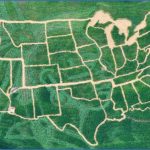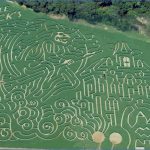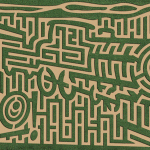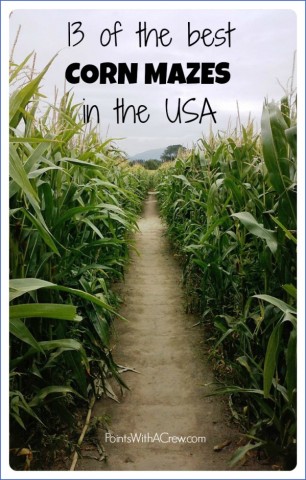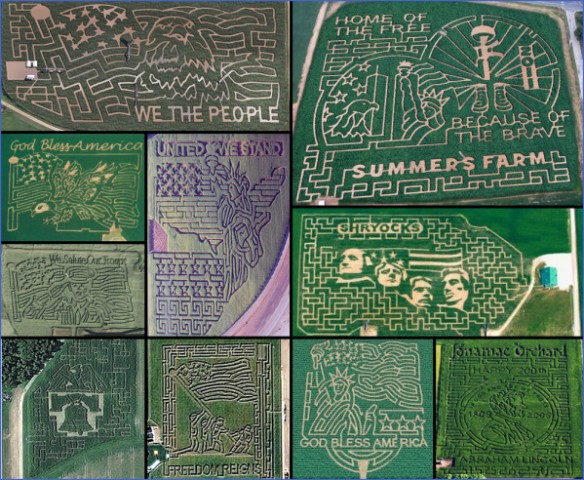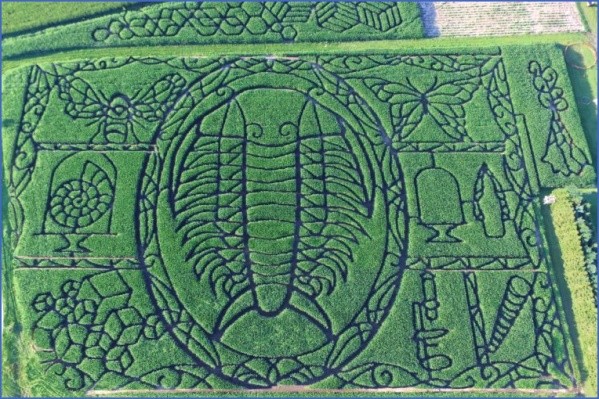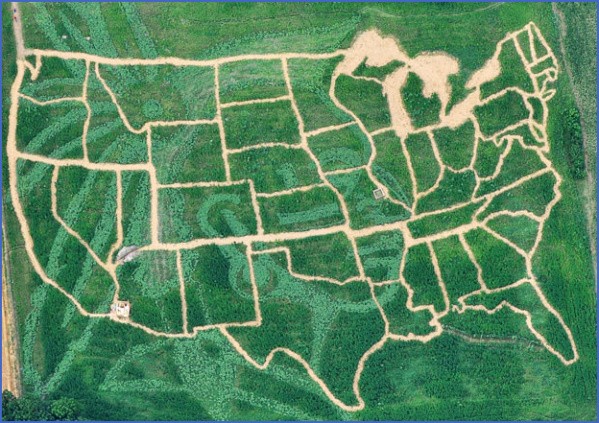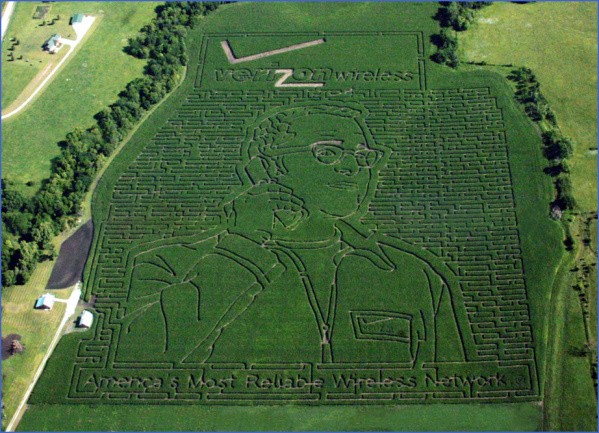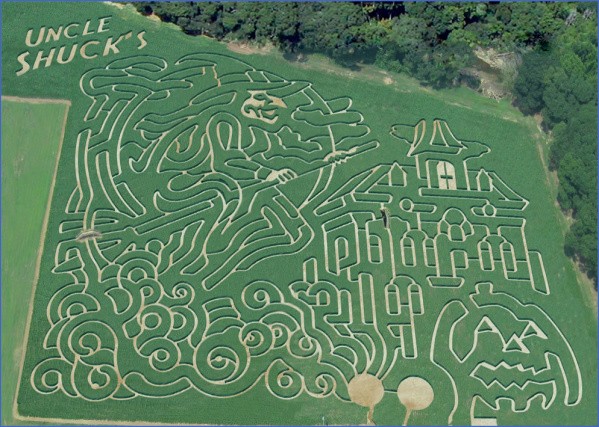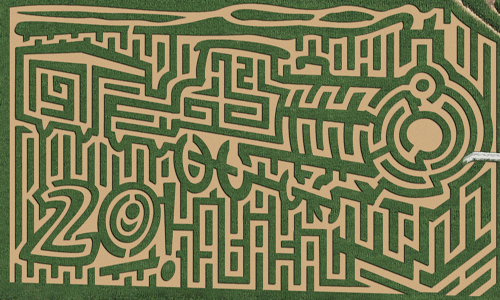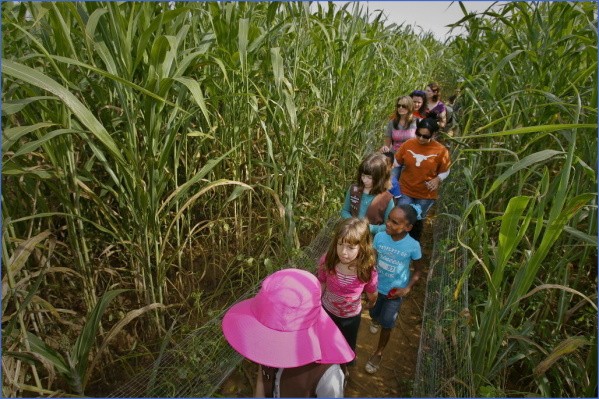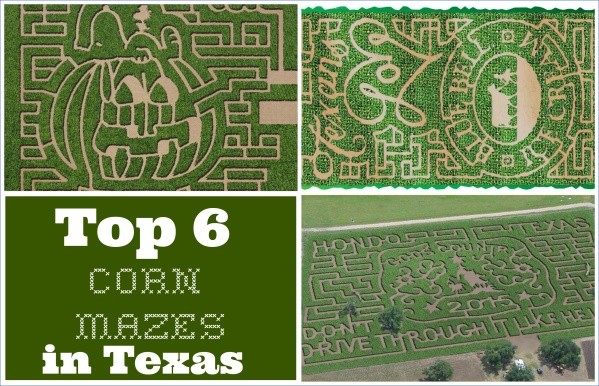Corn mazes are popular in the fall; many attract several thousand visitors during the Halloween season. The following are among the corn mazes that are most popular
with tourists (sources: Conde Nast Traveler and Travel Channel):
• Cherry Crest Adventure Farm (Ronks, PA; www.cherrycrestfarm.com)
• Connors Farm (Danvers, MA; www.connorsfarm.com)
• Cool Patch Pumpkins (Dixon, CA; www.coolpatchpumpkins.com)
• Davis Mega Maze (Sterling, MA; www.davisfarmland.com)
• Dewberry Farm (Brookshire, TX; www.dewberryfarm.com)
• Farmstead (Meridian, ID; www.farmsteadfestival.com)
• Fritzler’s Corn Maze (Greeley, CO; www.fritzlermaze.com)
Corn Mazes in USA Photo Gallery
• Great Vermont Corn Maze (Danville, VT; www.vermontcornmaze.com)
• Happy Day Farm (Manalapan, NJ; http://happydayfarmnj.com)
• Long & Scott Farms (Mt. Dora, FL; www.longandscottfarms.com)
• Queens Country Farm (Floral Park, NY; www.queensfarm.org)
• Richardson Farm Adventure (Spring Grove, IL; www.richardsonadventurefarm.com)
• Sever’s Corn Maze (Shakopee, MN; www.severscornmaze.com)
• The Corn Maze In The Plains (The Plains, VA; www.cornmazeintheplains.com)
• Treinen Farm (Lodi, WI; http://treinenfarm.com)
Ethnic Culture In Communities
Beyond museums, communities also mark ethnic culture. The following communities are among the best examples of America’s diversity (source: USA Weekend):
Barrio Historico in Tucson, AZ
• Long before the 1853 Gadsden Purchase placed southern Arizona under U.S. jurisdiction, the city of Tucson was a Spanish colonial outpost. When Mexico achieved independence in 1821, Tucson became part of the new country. Those transnational links survive in downtown’s Barrio Historico, whose 150 adobe row houses make up the country’s largest collection of traditional Sonoran architecture. The 20-block neighborhood is entered on the National Historic Register.
Brighton Beach, Brooklyn, NY
• The heart of the nation’s Russian Jewish community was born as a seaside resort in the Victorian age. By the 1920s, it had fallen out of fashion, creating a void that was filled by Eastern Europeans fleeing the aftermath of World War I. For the next 50 years, the sounds of Yiddish floated freely over a broad boardwalk. A second wave of immigration started in the late 1970s. The new residents came from the former Soviet Union by the tens of thousands. Import shops now line the commercial strip under Cyrillic lettering, vodka flows at glitzy nightclubs, and families fill restaurants for bar mitzvahs.
Cajun Country of Louisiana
• French-speaking Acadians drifted to southwestern Louisiana in the late 18th century – after the English drove them from Canada. On fertile land bounded by
winding bayous, the wanderers put down roots, becoming planters, ranchers, and defenders of a way of life that values family, the outdoors, good music, and great food. The culture thrives in New Iberia and the surrounding 22 counties of Cajun Country, where travelers can visit historic sites like Shadows-on-the-Teche, an 1834 manor built by a sugar planter; zap taste buds at a factory tour of McIlhenny Co., makers of Tabasco; meander through the moss-draped Jean Lafitte Scenic Byway; and dance a Cajun two-step to work up an appetite at New Iberia’s annual Gumbo Cookoff.
Chicago’s Polish neighborhoods
• With over one million Polish American residents, Chicago is second in Polish population only to Warsaw. By the 1920s, the city was the worldwide capital of Polish immigration. The legacy lives on in Avondale, northwest of the Loop, where Polish-speaking doctors and lawyers are almost as prevalent today as restaurants serving up pierogis, galumpkis, and sausages. No single neighborhood is big enough to contain the Polish population of Chicago. Their influence is visible in such institutions as the Holy Trinity Polish Mission and the Taste of Polonia festival, which draws 30,000 revelers each Labor Day.
Dearborn, MI, the Arab-American capital
• When it opened in 2005, Dearborn’s Arab American National Museum (www.arabamericanmuseum.org) became the first major cultural institution dedicated to the Arab-American experience. Standing directly across from Dearborn City Hall in the heart of America’s largest Middle Eastern community, the
38,000 sq. ft. museum reflects the rising political and cultural influence of Michigan’s nearly half-million Arabs. Middle Eastern immigration to the Detroit area began in the late 19th century. A generation later, the auto industry drew thousands more. Political strife in the Middle East after World War II spurred a second wave that continues today and encompasses Lebanese, Iraqis, Syrians, Palestinians, Egyptians, Jordanians, and more.
Harlem in New York City
• By turns chic and shabby, Harlem is many things to many people. To historians, it’s the legendary cultural capital of Black America, populated by Southern transplants in the early 20th century and put on the world map by W.E.B.
Du Bois, Langston Hughes, Zora Neale Hurston, and other bright lights of the Harlem Renaissance. To jazz aficionados, it’s the Savoy Ballroom, blowing sessions at Minton’s Playhouse, the Cotton Club, Ellington’s “A” Train, and the Deco-delicious Lenox Lounge, whose famous Zebra Room once belonged to Billie Holiday. To culinary tourists, it’s down-home soul kitchens and upscale Creole-fusion restaurants. To real estate developers, it’s a hot business opportunity in upper Manhattan, ripe for trendy clubs, pricey new condos, office space, and superstores. To its many residents, it’s home: a richly woven community that has weathered good times and bad, has deep Southern roots,
big Northern savvy, a storied past, and a bright future that will be influenced in untold ways by a current boom in immigration from Africa and Latin America.
Hmong community of Saint Paul, MN
• Some 1.1 million Hmong immigrants from Southeast Asia reside in the United States. More than any other city, they make their homes in Saint Paul, where local officials place the combined Minneapolis-Saint Paul population at more than 60,000. In the heart of Saint Paul’s University Avenue district, where an estimated 250 Hmong-owned businesses have helped revitalize an urban neighborhood, the Hmong Cultural and Resource Center presents exhibitions about Hmong history, culture, and life in the United States.
Little Havana in Miami, FL
• Each year on the last Friday of March more than a million people descend on Little Havana for the Calle Ocho festival, the country’s biggest Hispanic street party.
Food vendors, costume parades, merengue bands, and the longest conga line on Earth (119,000 strong in the record year of 1998) fill 15 blocks of Southwest Eighth Street (or Calle Ocho), the neighborhood’s main artery. Cuban emigres began colonizing the area after Castro’s revolution in 1959; subsequent waves of mass migration, including the “freedom flights” of 1965 and the Mariel Boatlift of 1980, brought hundreds of thousands more Cubans to Miami, firmly establishing Little Havana as a political cauldron, culinary mecca, and economic engine. Highlights for visitors include the Paseo de las Estrellas, a Latin American Walk of Fame; Cuban Memorial Boulevard, a greenway filled with monuments to Cuban patriots; and Maximo Gomez Park, known as Domino Park, where old-timers gather daily to swap gossip and games.
Little Tokyo in Los Angeles, CA
• Before World War II some 30,000 Japanese people lived, worked, and went to school in the downtown neighborhood known as Little Tokyo. The residential population never recovered from the internment of Japanese Americans during the war, but the four-block area remains the undisputed cultural hub of L.A.’s vast Japanese population – one of the largest outside of Japan. Attractions include restaurants; shops specializing in Japanese-language blogs, magazines, manga, and anime; traditional gardens; and Buddhist temples. At the Japanese American National Museum (www.janm.org), housed in a soaring pavilion designed by modern architect Gyo Obata, visitors can learn about the Japanese experience in America. The Japanese American Cultural & Community Center (www.jaccc.org) presents Kabuki drama and other performing arts.
Ohio’s Amish Country
• Holmes County, in the rolling hills of eastern Ohio, is home to nearly 40,000 Amish, the nation’s largest Amish enclave. Visitors can get a sense of the religion at the Amish and Mennonite Heritage Center (www.behalt.com) or take a buggy ride or tour a working farm at Schrock’s Amish Farm. Bed and breakfasts, country restaurants, and craft galleries dot the region.
Maybe You Like Them Too
- Top 10 Islands You Can Buy
- Top 10 Underrated Asian Cities 2023
- Top 10 Reasons Upsizing Will Be a Huge Travel Trend
- Top 10 Scuba Diving Destinations
- World’s 10 Best Places To Visit





